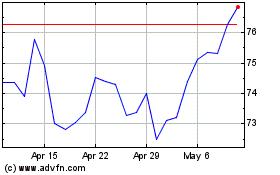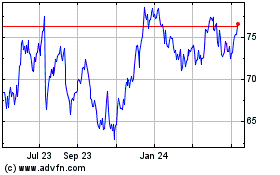By Ryan Tracy
WASHINGTON -- U.S. regulators are preparing to notify some of
the largest U.S. banks, including J.P. Morgan Chase & Co., that
they have submitted flawed plans detailing how they would handle a
potential bankruptcy, according to people familiar with the
matter.
The move, which could come as soon as this week, would raise the
prospect of higher capital requirements or other regulatory
sanctions for some of the institutions, and call into question
whether the firms remain "too big to fail" without a taxpayer
bailout.
At least half of the eight American banks labeled "systemically
important" by global regulators are expected to receive a harsh
verdict on their "living wills" that they were required to submit
under rules crafted since the financial crisis aimed at preventing
another bank bailout, these people said.
The long-awaited verdict by the Federal Reserve and Federal
Deposit Insurance Corp. is not yet final and could change, but
regulators are putting the finishing touches on their feedback to
the firms and will make their findings public soon, these people
said.
The Fed's governing board was set to hold a closed meeting
Tuesday afternoon to discuss the matter, one of the people
said.
Representatives for the Fed, FDIC and J.P. Morgan declined to
comment.
J.P. Morgan has previously said its living will is credible and
that it has a "fortress balance sheet" that would prevent it from
ever needing to tap taxpayers for help in a crisis. "We will be
vigilant and will never take such a high degree of risk that it
jeopardizes the health of our company....this is a bedrock
principle," Chief Executive James Dimon said in his recent
shareholder letter.
The adverse findings would mean J.P. Morgan and other firms will
have to rewrite their bankruptcy strategies to address issues
regulators have identified, or face sanctions, such as being
required to hold higher levels of capital, which restricts
borrowing and protects against losses -- but can also eat into
profitability. If they fail to submit credible strategies
repeatedly over a period of years, regulators could force them to
divest certain assets.
In addition to J.P. Morgan, regulators have significant concerns
about the bankruptcy strategies of the two so-called trust banks in
the group: Bank of New York Mellon Corp. and State Street Corp.,
according to people familiar with the matter. Regulators have also
been considering whether Bank of America Corp. should receive an
adverse verdict, these people said.
Representatives for Bank of New York, State Street and Bank of
America had no immediate comment.
Citigroup Inc. was expected to receive a positive finding from
regulators, these people said.
A Citigroup spokesman had no comment.
Details about the other three American banks covered by the
process -- Goldman Sachs Group Inc., Morgan Stanley and Wells Fargo
& Co. -- couldn't be confirmed.
The expected verdicts do not mean the regulators believe the
banks face any imminent danger of going out of business. Rather,
the whole exercise was designed to start with the premise that each
might one day face such extreme distress and show how they would
respond. The bankruptcy strategies also don't take into account the
fact that regulators could use other methods to avoid bailouts,
including using the FDIC's authority to take over and liquidate a
failing firm.
Regardless of what regulators say when they release their
findings, however, the decisions are likely to feed big-bank
critics across the political spectrum who say the government needs
to take drastic action to reduce the size and influence of large
Wall Street banks.
The regulators' rulings are likely to stir controversy, both
among banks and among political critics who see the whole
living-wills process as an example of postcrisis regulatory
overreach. House Republicans Tuesday released a report from the
Government Accountability Office that criticized the Fed and FDIC
for a lack of transparency in handling living wills. The
congressional watchdog said in its report that "may weaken public
and market confidence" in the plans "and limit the extent to which
the regulators can be held accountable for their decisions."
The agencies said in a letter in response to the report that
they are "committed to enhancing public disclosure" in the
living-will process.
Under the 2010 Dodd-Frank law, the eight U.S. banks designed as
crucial to the broader financial system must file living wills
showing they have a credible strategy to go through bankruptcy
without causing a broader economic panic or needing help from
taxpayers, one of many provisions in the law designed to prevent a
repeat of the 2008 bailouts.
Four foreign-owned U.S. banks, including units of Barclays PLC,
Credit Suisse Group AG, Deutsche Bank AG, and UBS Group AG, are
also expected to receive feedback on their bankruptcy strategies
this week, but regulators have been less concerned about those
firms because a requirement that they organize all their U.S.
operations under one holding company doesn't take effect until the
summer.
The firms first received individual feedback on their bankruptcy
strategies in 2014, when all but one of them, Wells Fargo, came up
well short of regulators' expectations. They resubmitted the plans
in July 2015 and have been waiting for feedback since.
In 2014, regulators issued only a general public statement
describing shortcomings in the firms' plans. This year, regulators
are expected to release specific information about problems at
individual firms, rather than lumping the group together, people
familiar with the matter said. One option on the table, these
people said, is releasing redacted versions of the private letters
that regulators send to firms detailing the feedback -- an outcome
that Fed Chairwoman Janet Yellen hinted at during recent
congressional testimony.
The language regulators use will be crucial. The Fed and FDIC
have been preparing to determine that a majority of the eight U.S.
firms, including J.P. Morgan, have living wills that either aren't
credible, or don't facilitate an orderly resolution, people
familiar with the matter said. Resolution is regulatory jargon for
unwinding a failing firm.
Dodd-Frank says that when regulators make that determination,
they must give firms a chance to fix deficiencies that regulators
identify, "including any proposed changes in business operations
and corporate structure to facilitate implementation of the
plan."
The firms would then have a chance to resubmit their living
wills, perhaps after a year. If those new plans again fail to
demonstrate that the banks could credibly go through an orderly
bankruptcy, regulators can impose further sanctions such as higher
capital requirements or restrictions on growth or activities. Two
years after the initial sanctions are imposed, regulators have the
power to force firms to divest assets or operations that are deemed
obstacles to an orderly bankruptcy.
The decisions may arrive as investors are already focused on the
financial conditions and strategies of the biggest banks. They are
reporting first-quarter earnings this week. J.P. Morgan kicks off
Wednesday, followed by Bank of America and Wells Fargo on Thursday,
and Citigroup on Friday. Investors and analysts anticipate a
quarter driven heavily by turbulent trading and energy exposures,
but a rebuke from regulators on living wills could also dominate
conversations.
Once the firms receive the letters from regulators, they will be
taking a close look at whether the Fed and FDIC have identified
problems that are fixable without significant changes to their
businesses. It is possible that regulators could identify problems
that don't require a significant reorganization, such as
deficiencies in the computer models firms use to predict the amount
of cash they would need during a bankruptcy.
Write to Ryan Tracy at ryan.tracy@wsj.com
(END) Dow Jones Newswires
April 12, 2016 17:06 ET (21:06 GMT)
Copyright (c) 2016 Dow Jones & Company, Inc.
State Street (NYSE:STT)
Historical Stock Chart
From Jun 2024 to Jul 2024

State Street (NYSE:STT)
Historical Stock Chart
From Jul 2023 to Jul 2024
